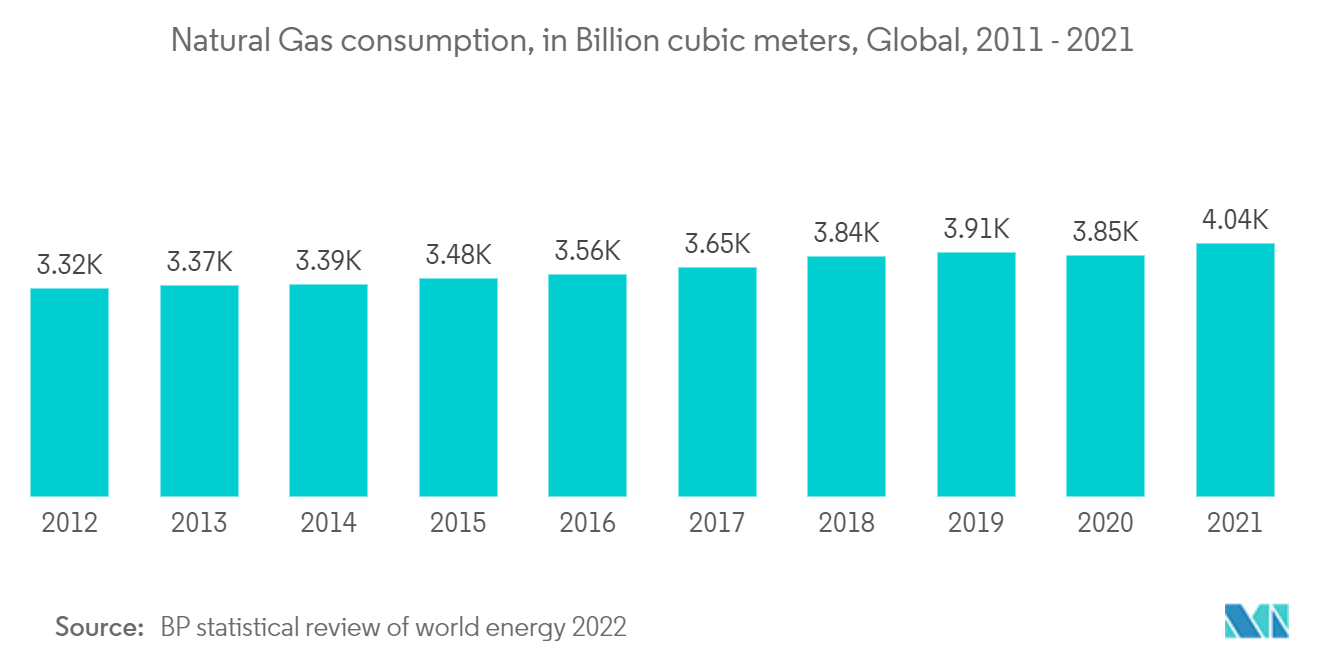Market Trends of Global LNG Liquefaction Terminals Industry
Rising the Demand for LNG in Bunkering, Road Transportation, and Off-grid Power.
- In the last decade, there has been a significant rise in industrialization and urbanization, which has resulted in a surge in carbon and greenhouse gases worldwide. Thus, to reduce carbon and greenhouse gas emissions, governments are promoting the utilization of natural gas in power generation and fuel in vehicles.
- Thus, governments are developing various supportive policies to increase the adoption of CNG and LNG-based vehicles, including providing subsidies and tax exemptions to automobile manufacturers and consumers.
- Resulting in increased natural gas consumption in the last decade across the globe. For instance, in 2012, the natural gas consumption was around 3,319.4 billion cubic meters which increased by more than 21% in 2021 to about 4,037.5 billion cubic meters.
- According to International Energy Agency, the Asia-Pacific region is expected to increase its total LNG imports from 69% in 2019 to 77% by 2025. China alone is anticipated to account for 22% of total LNG demand in 2025, contributing almost 40% of growth in total imports over the forecast period. India also leads LNG growth, accounting for about 20% of total trade, and sees its imports increase by 50% between 2019 and 2025 to support strong growth in demand.
- The United States is a significant locus of LNG activity. Stringent emission regulations in the marine sector also stimulate LNG as a bunker fuel in the United States and Europe. One of the biggest drivers in Europe and America is diesel replacement, for which natural gas is well suited. The European Union has the significant initiative of Sulfur Emission Control Areas (SECAs), and the United States has a parallel program.
- These initiatives are anticipated to boost the demand for LNG Liquefaction Terminals across the globe during the forecast period.
Middle East and Africa is Expected to Dominate the Market
- The Middle East and Africa include countries such as Qatar, Algeria, Nigeria, Egypt, Oman, Yemen, United Arab Emirates, and Angola. Qatar, Algeria, and Nigeria have the highest LNG liquefication facilities worldwide. Global liquefaction capacity reached 459.9 MTPA in 2021. Qatar, Algeria, and Nigeria had a total installed capacity of about 128.2 MTPA in 2021.
- Qatar continued to be the largest exporter of LNG until 2019. However, in 2021, Qatar's export volume dropped to the second position with a decrease export volume to 77 million tons accounting for 21% of the market share, compared to 77.1 million tons in 2020. Qatar utilizes its natural gas produced for electricity generation. In 2021, around 95% of the electricity generated in Qatar came from fossil fuels. Furthermore, the country utilizes its natural gas as LNG in ships or vessels operating on ocean water.
- Furthermore, Algeria is one of the major natural gas producers. In 2021, according to BP Statistical Review, natural gas production in Algeria surpassed 100 billion cubic meters, an increase of roughly 24% compared to 2020. The country is a net exporter of natural gas, whose export volume increased by around 10.4% to 16.1 bcm in 2021. The domestic natural gas demand is well covered by its gas infrastructure network, supplying all its domestic needs through its existing network.
- Similarly, Nigeria is one of the world's biggest exporters of LNG. Since the first train at Nigeria LNG was commissioned in 1999, the country has built a massive LNG export complex with a capacity of 22.5 million tons per annum (mtpa). In 2021, it held a 6% market share of the global LNG export market and was the world's sixth largest exporter of the commodity.
- According to the International Gas Union, Qatar and Nigeria have l approved liquefaction capacity of about 32 MTPA and 8 MTPA, which is expected to be operational in a couple of years. These developments are expected to drive the LNG liquefaction terminals market in the region.




